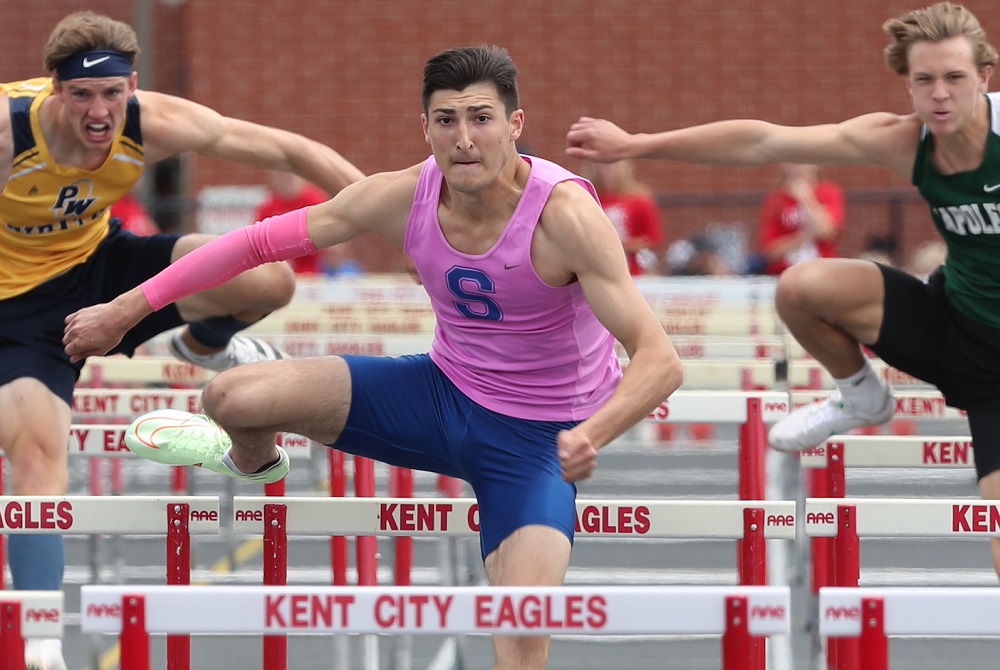
Diaz, Jones Star Again, While Lansing Catholic Follows Standout Pair
By
Scott DeCamp
Special for MHSAA.com
June 4, 2022
KENT CITY – Benny Diaz’ first three races of Saturday’s MHSAA Lower Peninsula Division 3 Track & Field Finals at Kent City High School said a lot about his considerable ability and sheer speed.
His fourth and final race said a lot about his character, even though he didn’t win that one.
The Saugatuck senior blazed to championships in the 110-meter hurdles (13.64 seconds), 100 dash (11.16) and 300 hurdles (39.43) before he pulled up with a hamstring injury near the midway point of the 200 dash.
Diaz, a University of Michigan signee, had a chance to become a four-event winner, but it was not in the cards. After he bent over at the waist and paused on the track, he finished the 200 in a slow trot as the packed stands cheered him to the finish line. He was “slightly upset,” but just wanted to finish the race.
“I’d say it’s better to finish it than to just stop,” Diaz said. “I guess it says a lot about your character. You’re willing to finish things, even if it’s not going so well.”
Diaz’ injury opened the door for Lansing Catholic to capture its second Division 3 team championship, and first since 2012. Lansing Catholic finished with 38 points to edge Saugatuck by a single point.
Led by junior Hunter Jones’ pair of individual titles, Benzie Central placed third with 32 points. Pewamo-Westphalia (30) and Hart (29) rounded out the top five.
Lansing Catholic took first in the final race of the day, the 1,600 relay (3:25.91), to push the Cougars over the top. Senior Josh Otten anchored that winning relay, placed runner-up in the 400 and third in the 1,600, and he anchored the second-place 3,200 relay. Senior Dave Pruder was third in the 800, and he joined Otten on the aforementioned relays that scored valuable points for the Cougars.
“Every one of them came through,” said Lansing Catholic coach Tim Simpson, who also guided the Cougars to the Division 3 title in 2012. “Otten came through with a huge day, Pruder came through with a huge day. Everybody else did their job.”
Jones captured championships in the 800 (personal record 1:52.68) and 1,600 (4:10.68), and he finished second in the 3,200 (9:25.87) to join Diaz as one of the top performers of the meet.
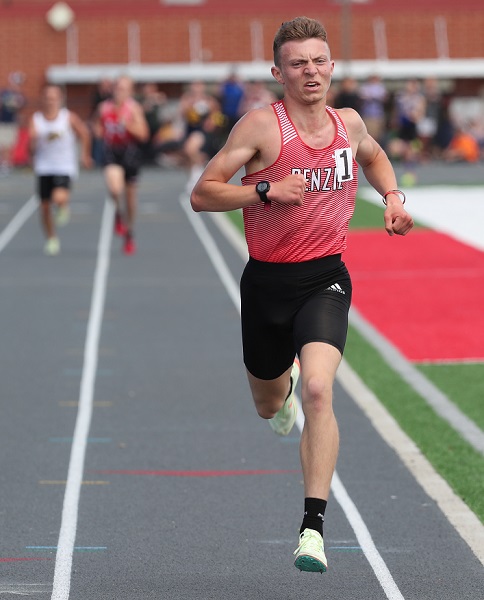 Jones now has three MHSAA track state titles under his belt, as well as three Division 3 cross country championships. He won the 1,600 at last year’s Finals.
Jones now has three MHSAA track state titles under his belt, as well as three Division 3 cross country championships. He won the 1,600 at last year’s Finals.
“I was comfortable for the mile and the 800 I was strong, but after the 800 I was at the trash can – I wasn’t feeling well,” said Jones, who is close to announcing his college commitment to a Division I school but is keeping that announcement close to the vest.
“My coaches, they helped me out. They helped me gain confidence and I threw myself on the track, got around eight laps and got runner-up (in the 3,200).”
Diaz finishes his storybook high school track career with five total Finals titles, going back-to-back in both hurdles events as a junior and senior.
Hurdles are the specialty for the slender Diaz, a 6-foot-1, 160-pounder, who glides along the track and makes it look effortless.
Seemingly stuck with the pack in the 100 on Saturday, Benny turned on his jets in the final 30 meters and burst to an impressive victory. He said that he tends to be a slower starter and strong finisher.
“Oh, no, it’s like that – it’s like that,” Diaz said with a grin. “I can just be lackadaisical before the start and just, it turns on. I mean, that’s just the type of kid I am, kind of low energy, just chill. Don’t get too high, don’t get too low.
“That’s just my race. I’m usually behind at the start and then I catch up with my top speed – speed and endurance.”
Diaz hobbled to the medal stand after the 200. He attributed the left hamstring injury to nerve problems, which flared up Friday.
He said he didn’t know how the nerve issues started and was hoping it wouldn’t be an issue Saturday.
“I’ve just been managing it. I was trying to keep it a secret, but now it’s kind of out the window,” a smiling Diaz said.
“But, I mean, I’m still happy with 30 points.”
Other individual champions included Sanford Meridian’s Dane Plichta in the 200 (22.82), Richmond’s Evan Green in the 400 (49.79 PR), Manton’s Noah Morrow in the 3,200 (9:17.84), Mason County Central’s Andrew Quinn in shot put (61-1.5 PR), Hart’s Kellen Kimes in discus (165-10 PR), Lake City’s Gavin Bisballe in high jump (6-5), Ovid-Elsie’s Tryce Tokar in pole vault (14-3 PR) and Warren Michigan Collegiate’s Trevon Redding in long jump (22-5).
Other first-place relay teams included Madison Heights Bishop Foley in the 400 (44.38), Sanford Meridian in the 800 (1:30.97), and Traverse City St. Francis in the 3,200 (8:10.56).
Grosse Pointe Woods University Liggett sophomore Jacob Juip competed in the first-time adaptive events in the 100 (57.63) and 200 (2:17.57).
PHOTOS (Top) Saugatuck's Benny Diaz, middle, builds his lead in the 110 hurdles Saturday at Kent City. (Middle) Benzie Central's Hunter Jones sets the pace on the way to one of his two race wins. (Click for more by Carter Sherline/Run Michigan.)
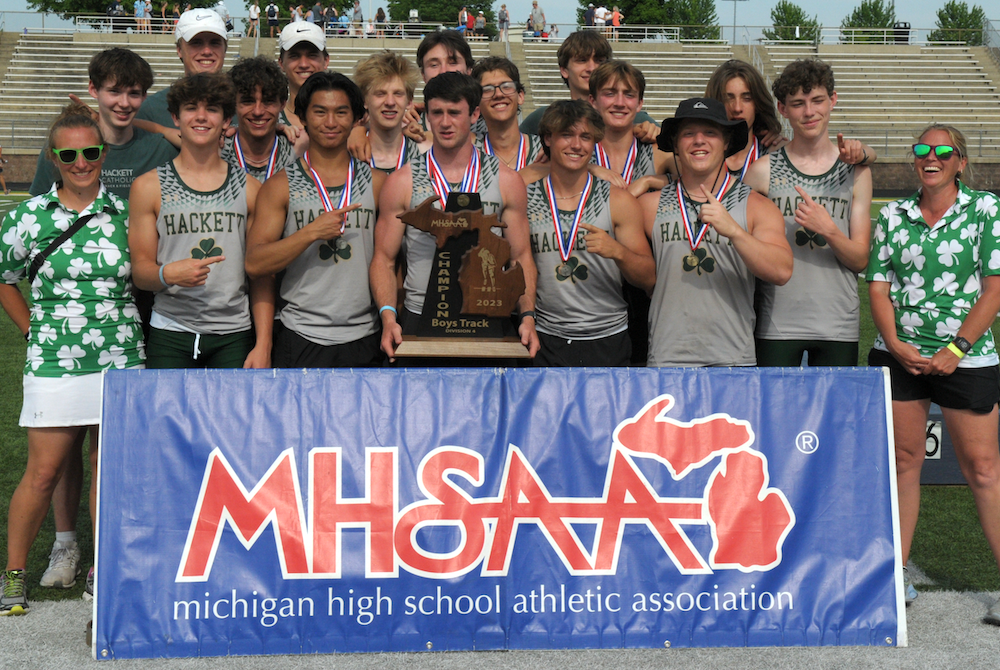
Thrower Claims Lone Individual Title to Lead Hackett to Team 3-Peat
By
Tom Lang
Special for MHSAA.com
June 3, 2023
Kalamazoo Hackett Catholic Prep just keeps winning and winning.
This time the Irish took home their fourth title in the last five Lower Peninsula Division 4 Track & Field Finals, on Saturday at Hudsonville.
Hackett’s only individual title was taken by discus winner Nathan Buchmann, a senior, who was fine knowing he was the shortest in stature among all the sizable competitors.
“In the offseason after football I worked out every day, working towards this goal,” he said after getting his medal. “I would say this takes 80 percent technique and 20 percent strength to throw the discus. So, length can help but if you have good technique and are really strong, that will play into it.
“I think we are very balanced throughout the meet today,” he said about teammates that scored points in finishes other than first place. “We have 13 guys here today, and we have people in a lot of the races. But I do not run; I have too short of legs to be a fast runner,” he said with a chuckle.
Buchmann had to work through a hip injury to compete this spring.
“I think the setbacks are what make you strong,” he said. “You can either give up through the setbacks or push forward and become better.”
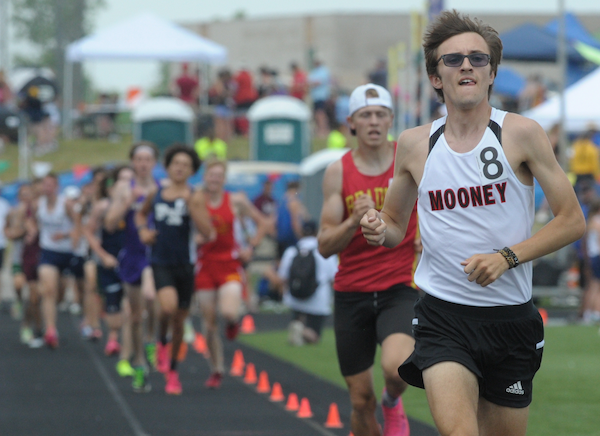 Coach Charissa Dean agreed.
Coach Charissa Dean agreed.
“The kids have big hearts,” she said after all the points were totaled and the Irish were on top once again, with 53. “They worked hard. They had a lot of potential when we started the season. And we had a lot of drive to put in the work, and we are happy the results came out the way they did.”
Reading was runner-up at 47 points, followed by Wyoming Potter’s House Christian with 42, then Fowler and Flint Beecher each with 37 points.
Senior Lezawe “Moses” Osterink, of Potter’s House Christian, placed second in 1,600 but took the 3,200 title as defending champ of both. He dominated the latter by lapping the field with a final lap kick that resembled more of a superhero speedster.
“Nobody really took it out that hard at the start,” he said. “There was a freshman (Marek Butkiewicz of Hackett) that tried to get the pace going quick, but me and Dakota (Dykhuis of Montabella) just kind of sat back and gradually pulled him through.
“We took it gradually, and I was just relying that I could kick.”
Kick did he ever. The trio were neck and neck the majority of the race in a grouping ahead of the pack.
“With 400 to go I just tried to go all out,” Osterink said. “I had a lot more left than I thought and I was pleased with the win. Not really the time, but that doesn’t matter, especially this hot out.”
The overall meet was in the low 90s/high 80s heat and searing sun all day. So, race officials allowed the unique opportunity for coaches to spray the runners with water and give them water bottles.
“It was very weird because I’ve never taken water to drink while I’m running, so I didn’t know how that would feel,” Osterink said. “And they were spraying us and hitting us in the face. It was kind of fun.”
Junior Tyler Lenn of Marine City Cardinal Mooney defeated Osterink at his own game in the 1,600.
“I’m feeling great,” Lenn said after grabbing the medal. “I said to a newspaper after one of my races (during the season) I was right where I wanted to be. This has been a long rebuilding process for me since an injury back in the fall, and I set a pretty high goal the day the injury happened. I was telling myself I needed to fulfill what I said I would do at the beginning of last cross country season. And that is what I did today.”
Lenn suffered an ankle sprain from a misstep that turned worse because he kept running through the season on it.
“Coming back from that was pretty tough, but I wouldn’t have it any other way,” he said. 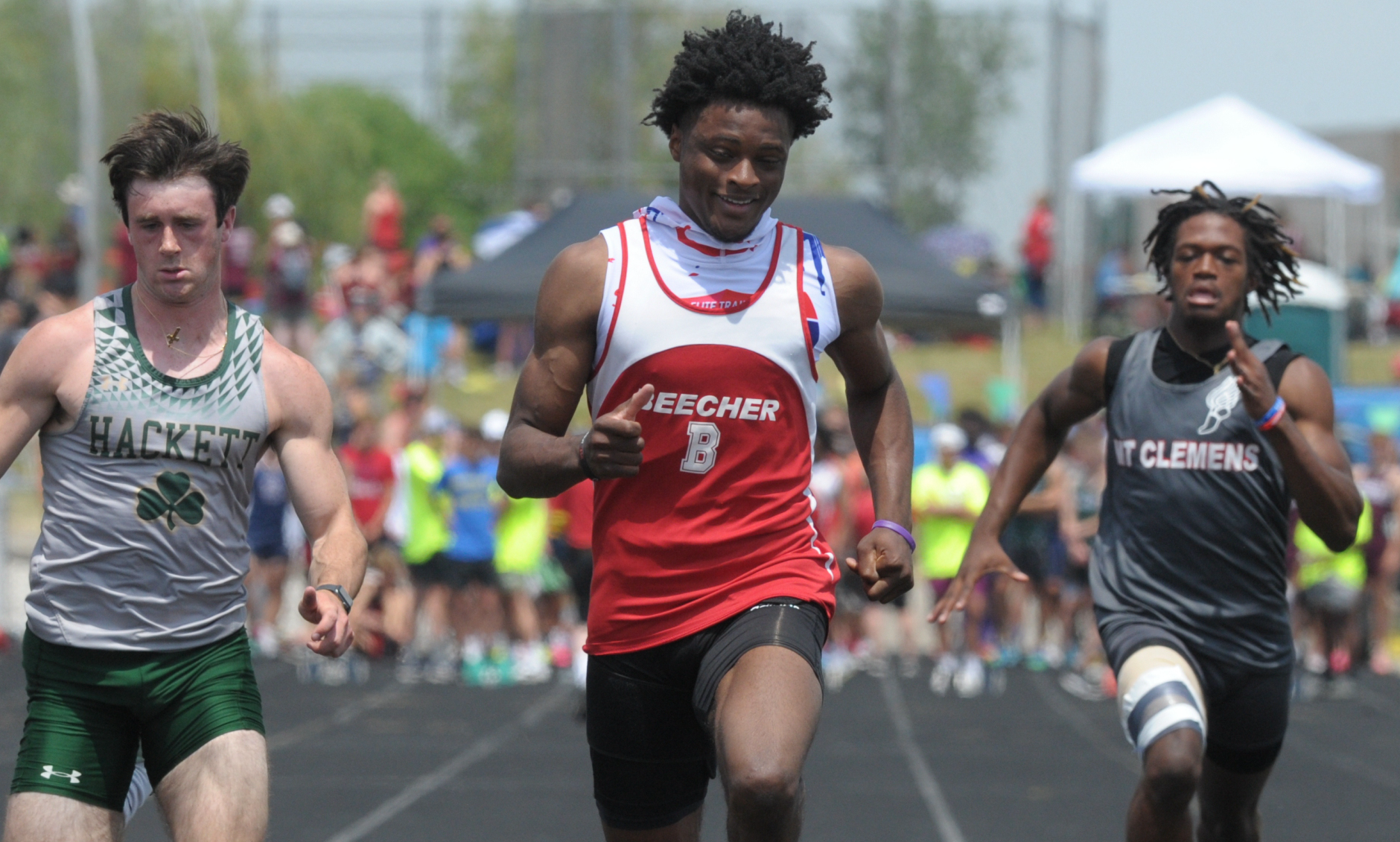 “Perseverance; I said from the beginning what I was going to do. I kept my eye on that target, and no matter the circumstances life threw at me, that I was going to make it happen and I am a man of my word.”
“Perseverance; I said from the beginning what I was going to do. I kept my eye on that target, and no matter the circumstances life threw at me, that I was going to make it happen and I am a man of my word.”
Jaylin Townsend, a senior from Flint Beecher, dominated the short races. He won the 100 dash (10.67) and 200 dash at 22 seconds flat. It was his third 100 win at a Finals.
“I put in a lot of work; I had to three-peat,” he said after the 100. “There’s a lot of great competition here, so I knew I had to come out and run my best.”
Concord in the 400 (43.72), Buckley in the 800 (1:30.76) and 1,600 (3:29.13) and Potter’s House in the 3,200 (8:14.18) were relay champs Saturday. Reading’s Tayshawn Bester won the 110 hurdles (15.13), and Athens’ Landen Bennett won the 300 (39.85). Caseville’s Nathan Feltner won the 400 (50.76), and Vestaburg’s Owen Patton claimed the 800 (1:55.11).
Fruitport Calvary Christian’s Bradley Richards won the high jump (6-10), and Peck’s Alex Affer won the long jump (23-4). McBain Northern Michigan Christian’s Isaac Bowden was first in pole vault (13-0), and Brown City’s Kyle Affer won shot put (49-2).
PHOTOS (Top) Kalamazoo Hackett Catholic Prep celebrates its third-straight LPD4 title Saturday. (Middle) Cardinal Mooney's Tyler Lenn, far right, sets the pace in the 1,600. (Below) Flint Beecher's Jaylin Townsend, middle, crosses the finish first for one of his two sprint championships. (Photos by Ken Swart/RunMichigan.com.)

